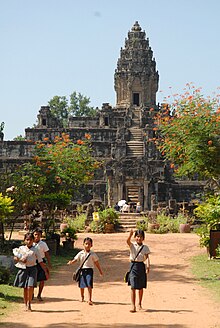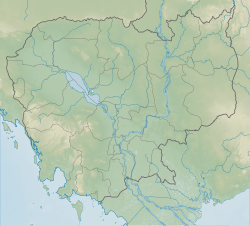Hariharalaya: Difference between revisions
Undid revision 1222870746 by 2409:40F3:101E:7DDC:8000:0:0:0 (talk) rv IP sock of indef blocked User:Vishal Kandassamy per WP:BANREVERT |
RV uncited changes by account sock of to be blocked user Jpeeling Tags: Manual revert Reverted Visual edit Mobile edit Mobile web edit |
||
| Line 4: | Line 4: | ||
| native_name = ហរិហរាល័យ |
| native_name = ហរិហរាល័យ |
||
| native_name_lang = Km |
| native_name_lang = Km |
||
| alternate_name = [[Roluos (temples)|Roluos]] |
| alternate_name = [[Roluos (temples)|Roluos]] |
||
| |
| alt = Location of Hariharalaya in Cambodia |
||
| caption = Location of Hariharalaya in Cambodia |
|||
| image_size = |
|||
| alt = |
|||
| caption = |
|||
| map = |
|||
| map_type = Cambodia |
| map_type = Cambodia |
||
| map_alt = |
|||
| map_caption = Location in Cambodia |
| map_caption = Location in Cambodia |
||
| map_size = 250 |
| map_size = 250 |
||
| altitude_m = |
|||
| altitude_ref = |
|||
| relief = yes |
| relief = yes |
||
| coordinates = {{coord|13|20|N|103|58|E|display=inline,title}} |
| coordinates = {{coord|13|20|N|103|58|E|display=inline,title}} |
||
| gbgridref = |
|||
| map_dot_label = Hariharalaya |
| map_dot_label = Hariharalaya |
||
| location = [[Siem Reap province|Siem Reap]], [[Cambodia]] |
| location = [[Siem Reap province|Siem Reap]], [[Cambodia]] |
||
| region = Southeast Asia |
| region = Southeast Asia |
||
| type = Archaeological site |
| type = Archaeological site |
||
| part_of = |
|||
| length = |
|||
| width = |
|||
| area = |
|||
| volume = |
|||
| diameter = |
|||
| circumference = |
|||
| height = |
|||
| builder = [[Jayavarman II]] |
| builder = [[Jayavarman II]] |
||
| material = [[sandstone]], [[laterite]], [[brick]] |
| material = [[sandstone]], [[laterite]], [[brick]] |
||
| built = |
| built = 802 CE |
||
| abandoned = |
| abandoned = 889 CE |
||
| epochs = |
| epochs = [[Angkor period]] |
||
| |
| condition = Ruined |
||
| dependency_of = |
|||
| occupants = |
|||
| event = |
|||
| discovered = |
|||
| excavations = |
|||
| archaeologists = |
|||
| condition = ruined |
|||
| ownership = |
|||
| management = |
|||
| public_access = Yes |
| public_access = Yes |
||
| ⚫ | |||
| other_designation = |
|||
| website = <!-- {{URL|example.com}} --> |
|||
| ⚫ | |||
| architectural_details = |
|||
| notes = |
|||
}} |
|||
{{Contains special characters|Khmer}} |
{{Contains special characters|Khmer}} |
||
'''Hariharalaya''' ({{lang-km|ហរិហរាល័យ}}, '''Hariharalaya''') was an ancient city and capital of the [[Khmer empire]] located near [[Siem Reap]], [[Cambodia]] in an area now called [[Roluos (temples)|Roluos]] ([[Khmer language|Khmer]]: រលួស). Today, all that remains of the city are the ruins of several royal temples: [[Preah Ko]], |
'''Hariharalaya''' ({{lang-km|ហរិហរាល័យ}}, '''Hariharalaya''') was an ancient city and capital of the [[Khmer Empire|Khmer empire]] located near [[Siem Reap]], [[Cambodia]] in an area now called [[Roluos (temples)|Roluos]] ([[Khmer language|Khmer]]: រលួស). Today, all that remains of the city are the ruins of several royal temples: [[Preah Ko]], [[Bakong]], [[Lolei]].<ref name=Higham>Higham, C., 2001, The Civilization of Angkor, London: Weidenfeld & Nicolson, {{ISBN|9781842125847}}</ref>{{rp|60}}<ref name=Higham1>Higham, C., 2014, Early Mainland Southeast Asia, Bangkok: River Books Co., Ltd., {{ISBN|9786167339443}}</ref>{{rp|353–357}} |
||
==Etymology== |
==Etymology== |
||
[[File:Harihara Musée Guimet 897 1.jpg|right|thumb|This 7th century CE statue of Harihara is from [[Angkor Borei and Phnom Da|Phnom Da]] in [[Cambodia]].]] |
[[File:Harihara Musée Guimet 897 1.jpg|right|thumb|This 7th century CE statue of Harihara is from [[Angkor Borei and Phnom Da|Phnom Da]] in [[Cambodia]].]] |
||
The name "Hariharalaya" is derived from the name of [[Harihara]], a [[Hindu]] god prominent in |
The name "Hariharalaya" is derived from the name of [[Harihara]], a [[Hinduism|Hindu]] god prominent in the[[Khmer Empire]], which is today [[Cambodia]]. The name "Harihara" in turn is a composite of "Hari" (a name of the Hindu god [[Vishnu]]) and "Hara" (a name of the Hindu god [[Shiva]]) because Harihara is both Vishnu and Shiva combined. Khmer statues of Harihara show him being both [[Vishnu]] and [[Shiva]] combined. For example, the god's head-covering consisted of a mitre-type crown (Vishnu) on one side and as twisted locks of hair (Shiva) on the other. Alaya is a Sanskrit word meaning "temple", so Hariharalaya means the home of a temple dedicated to the god Harihara. |
||
==History== |
==History== |
||
[[File:Bakong2.JPG|thumb|left| |
[[File:Bakong2.JPG|thumb|left|[[Bakong]] is the royal temple mountain founded by King [[Indravarman I]] at Hariharalaya.]] |
||
Toward the end of the 8th century CE, the Cambodian king [[Jayavarman II]] conquered vast territories near the great lake [[ |
Toward the end of the 8th century CE, the Cambodian king [[Jayavarman II]] conquered vast territories near the great lake [[Tonlé Sap]]. For at least part of this time, he established his capital at Hariharalaya.<ref>O'Reilly, Dougald J.W. ''Early Civilizations of Southeast Asia''. Rowman & Littlefield Pub Inc. 2006. {{ISBN|978-0-7591-0279-8}}. pp.123-124</ref><ref name=Coedes/>{{rp|98}} However, when he declared himself the universal monarch of the country in 802 CE, he did so not at Hariharalaya, but at [[Mahendraparvata]] on the [[Phnom Kulen]] Plateau. Later, he returned the capital to Hariharalaya, where he died in 835 CE.<ref>Freeman and Jacques, p.9.</ref> |
||
[[Jayavarman II]] was succeeded by [[Jayavarman III]] and then by [[Indravarman I]], who were responsible for the completion of the royal temple mountain known as the [[Bakong]] and the construction of |
[[Jayavarman II]] was succeeded by [[Jayavarman III]] and then by [[Indravarman I]], who were responsible for the completion of the royal temple mountain known as the [[Bakong]] and the construction of the lake Indratataka.<ref name=Coedes>Coèdes, George (edited by Walter F. Vella; translated by Susan Brown Cowing). ''The Indianized states of Southeast Asia''. University of Hawai`i Press. 1986. {{ISBN|978-0-8248-0368-1}}. p.110ff</ref> [[Indravarman I]] consecrated the temple's dominant religious symbol, a [[lingam]] statue of Shiva called Indreshvara (the name is a combination of the king's name with that of Shiva, meaning lord of Indra, who is the king Indravarman I), in 881 CE. Indravarman I also constructed the much smaller temple today called [[Preah Ko]] ("Sacred Bull", meaning [[Nandi (Hinduism)|Nandi]]), dedicated in 880 CE. In 889 CE, Indravarman I was succeeded by his son [[Yasovarman I]], who constructed the temple of [[Lolei]] (the name may be a modern corruption of "Hariharalaya") on an artificial island in the middle of the lake Indratataka.<ref>The reason for its offset towards the north seems to be that Indravarman closed off hastily the north side while preparing to move the capital to Angkor site, as in Freeman and Jacques, p.202</ref> [[Yasovarman I]] also founded a new city at the site of [[Angkor Thom]] north of modern [[Siem Reap]] and called it [[Yaśodharapura]]. Yasovarman made the new city his capital and constructed a new royal temple mountain, known as [[Phnom Bakheng]]. Yaśodharapura was to survive until the 1170s CE when it was sacked by invaders from [[Champa]].<ref>Freeman and Jacques, p.9ff.</ref> |
||
{{clear}} |
{{clear}} |
||
==See also== |
==See also== |
||
* [[Angkor]] |
* [[Angkor]] |
||
* [[ |
* [[Khmer architecture]] |
||
* [[Preah Ko]] |
* [[Preah Ko]] |
||
* [[Bakong]] |
* [[Bakong]] |
||
Revision as of 17:49, 8 May 2024
ហរិហរាល័យ | |
 Location of Hariharalaya in Cambodia | |
| Alternative name | Roluos |
|---|---|
| Location | Siem Reap, Cambodia |
| Region | Southeast Asia |
| Coordinates | 13°20′N 103°58′E / 13.333°N 103.967°E |
| Type | Archaeological site |
| History | |
| Builder | Jayavarman II |
| Material | sandstone, laterite, brick |
| Founded | 802 CE |
| Abandoned | 889 CE |
| Periods | Angkor period |
| Site notes | |
| Condition | Ruined |
| Public access | Yes |
| Architecture | |
| Architectural styles | Preah Ko |
Hariharalaya (Khmer: ហរិហរាល័យ, Hariharalaya) was an ancient city and capital of the Khmer empire located near Siem Reap, Cambodia in an area now called Roluos (Khmer: រលួស). Today, all that remains of the city are the ruins of several royal temples: Preah Ko, Bakong, Lolei.[1]: 60 [2]: 353–357
Etymology

The name "Hariharalaya" is derived from the name of Harihara, a Hindu god prominent in theKhmer Empire, which is today Cambodia. The name "Harihara" in turn is a composite of "Hari" (a name of the Hindu god Vishnu) and "Hara" (a name of the Hindu god Shiva) because Harihara is both Vishnu and Shiva combined. Khmer statues of Harihara show him being both Vishnu and Shiva combined. For example, the god's head-covering consisted of a mitre-type crown (Vishnu) on one side and as twisted locks of hair (Shiva) on the other. Alaya is a Sanskrit word meaning "temple", so Hariharalaya means the home of a temple dedicated to the god Harihara.
History

Toward the end of the 8th century CE, the Cambodian king Jayavarman II conquered vast territories near the great lake Tonlé Sap. For at least part of this time, he established his capital at Hariharalaya.[3][4]: 98 However, when he declared himself the universal monarch of the country in 802 CE, he did so not at Hariharalaya, but at Mahendraparvata on the Phnom Kulen Plateau. Later, he returned the capital to Hariharalaya, where he died in 835 CE.[5]
Jayavarman II was succeeded by Jayavarman III and then by Indravarman I, who were responsible for the completion of the royal temple mountain known as the Bakong and the construction of the lake Indratataka.[4] Indravarman I consecrated the temple's dominant religious symbol, a lingam statue of Shiva called Indreshvara (the name is a combination of the king's name with that of Shiva, meaning lord of Indra, who is the king Indravarman I), in 881 CE. Indravarman I also constructed the much smaller temple today called Preah Ko ("Sacred Bull", meaning Nandi), dedicated in 880 CE. In 889 CE, Indravarman I was succeeded by his son Yasovarman I, who constructed the temple of Lolei (the name may be a modern corruption of "Hariharalaya") on an artificial island in the middle of the lake Indratataka.[6] Yasovarman I also founded a new city at the site of Angkor Thom north of modern Siem Reap and called it Yaśodharapura. Yasovarman made the new city his capital and constructed a new royal temple mountain, known as Phnom Bakheng. Yaśodharapura was to survive until the 1170s CE when it was sacked by invaders from Champa.[7]
See also
References
- Freeman, Michael and Jacques, Claude. Ancient Angkor. River Books. 2006. ISBN 974-8225-27-5.
- Falser, Michael. The Pre-Angkorian Temple of Preah Ko. A Sourcebook of the History, Construction and Ornamentation of the Preah Ko Style. White Lotos Publication. Bangkok 2006. (200 pages, ISBN 974-480-085-2)
Footnotes
- ^ Higham, C., 2001, The Civilization of Angkor, London: Weidenfeld & Nicolson, ISBN 9781842125847
- ^ Higham, C., 2014, Early Mainland Southeast Asia, Bangkok: River Books Co., Ltd., ISBN 9786167339443
- ^ O'Reilly, Dougald J.W. Early Civilizations of Southeast Asia. Rowman & Littlefield Pub Inc. 2006. ISBN 978-0-7591-0279-8. pp.123-124
- ^ a b Coèdes, George (edited by Walter F. Vella; translated by Susan Brown Cowing). The Indianized states of Southeast Asia. University of Hawai`i Press. 1986. ISBN 978-0-8248-0368-1. p.110ff
- ^ Freeman and Jacques, p.9.
- ^ The reason for its offset towards the north seems to be that Indravarman closed off hastily the north side while preparing to move the capital to Angkor site, as in Freeman and Jacques, p.202
- ^ Freeman and Jacques, p.9ff.
External links
- Beyond Angkor: Historical Sites at Hariharalaya - Unique Graphical Interactive Maps and info about all the ancient historical sites

